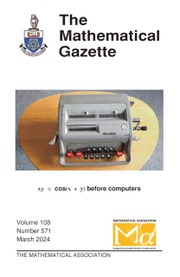No CrossRef data available.
Article contents
Visualising alternating geometric series
Published online by Cambridge University Press: 20 June 2025
Extract
When first learning about geometric series, students often wonder why these series are termed 'geometric'. The geometry of some geometric series is readily apparent for some common series such as $$\sum\limits_{n = 1}^\infty{\left( {\frac{1}{2}} \right)}^n = \frac{1}{2} + \frac{1}{4} + \frac{1}{8} + ...{\text{ }}.$$
$$\sum\limits_{n = 1}^\infty{\left( {\frac{1}{2}} \right)}^n = \frac{1}{2} + \frac{1}{4} + \frac{1}{8} + ...{\text{ }}.$$
Information
- Type
- Articles
- Information
- Copyright
- © The Authors, 2025 Published by Cambridge University Press on behalf of The Mathematical Association
References
Plaza, A., Sum of an alternating geometric series via self-similarity. American Mathematical Monthly, 129(4) (2022) p. 380.CrossRefGoogle Scholar
Chakraborty, B., Sum of a geometric series via the integral
 $\int_1^r {\frac{1}{x}dx}$
. American Mathematical Monthly, 130 (8) (2023) p. 764.CrossRefGoogle Scholar
$\int_1^r {\frac{1}{x}dx}$
. American Mathematical Monthly, 130 (8) (2023) p. 764.CrossRefGoogle Scholar
Sinha, R., Visualizing an alternating series. Ohio Journal of School Mathematics, 92 (2022) pp. 57–61. https://library.osu.edu/ojs/index.php/OJSM/article/view/9282/7772
Google Scholar
Rep-tile,Wikipedia, accessed November 2024 at https://en.wikipedia.org/wiki/Rep-tile
Google Scholar


